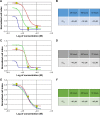In vitro study on anti-cancer properties of genistein in tongue cancer
- PMID: 29180873
- PMCID: PMC5692202
- DOI: 10.2147/OTT.S133632
In vitro study on anti-cancer properties of genistein in tongue cancer
Abstract
Purpose: Tongue cancer is an extremely aggressive disease and is characterized by a poor prognosis. It is a complex disease to treat and current therapies have produced mediocre results with many side effects. Some facts suggest that natural essences can support traditional cancer therapy by carrying out a synergistic function with chemotherapy. Therefore, we evaluated the antitumor effects of genistein on tongue carcinoma cells.
Methods: Genistein 20, 50 and 100 µM were used for 24, 48 and 72 hours on 3 tongue carcinoma cell lines. xCELLigence system was used to evaluate the effects on cell adhesion, proliferation and to calculate IC50 values. Both MTT assay and Trypan blue assay were used to evaluate alterations in cell viability, scratch assay for cell migration and Western blot analysis for expression of some proteins.
Results: Cell adhesion was inhibited especially between 20 and 50 µM of genistein treatment. Proliferation was reduced by 50% for treatments with 20 µM at 24 hours, with 20 or 50 µM at 48 and 50 µM at 72 hours (P<0.0001). Viability tests confirmed a proportional reduction in concentration of genistein and duration of treatments. Even cell migration was reduced significantly (P<0.001). Genistein down-regulates vitronectin, OCT4 and survivin.
Conclusion: This in vitro study clarifies the anti-tumor effect of genistein on tongue carcinoma. In vivo studies are needed to confirm these data and develop a suitable delivery system that is capable of acting directly on tumor.
Keywords: cell adhesion; cell proliferation; genistein; tongue cancer; xCELLgence system.
Conflict of interest statement
Disclosure The authors report no conflicts of interest in this work.
Figures







Similar articles
-
Effects of Curcumin on Squamous Cell Carcinoma of Tongue: An In Vitro Study.Curr Top Med Chem. 2018;18(3):233-243. doi: 10.2174/1568026618666180412153824. Curr Top Med Chem. 2018. PMID: 29651934
-
Genistein induced anticancer effects on pancreatic cancer cell lines involves mitochondrial apoptosis, G0/G1cell cycle arrest and regulation of STAT3 signalling pathway.Phytomedicine. 2018 Jan 15;39:10-16. doi: 10.1016/j.phymed.2017.12.001. Epub 2017 Dec 5. Phytomedicine. 2018. PMID: 29433670
-
[Effects of Genistein on the proliferation and expression of survivin in salivary adenoid cystic carcinoma cell line SACC-83].Hua Xi Kou Qiang Yi Xue Za Zhi. 2007 Feb;25(1):97-9. Hua Xi Kou Qiang Yi Xue Za Zhi. 2007. PMID: 17375591 Chinese.
-
Genistein inhibits migration and invasion of cervical cancer HeLa cells by regulating FAK-paxillin and MAPK signaling pathways.Taiwan J Obstet Gynecol. 2020 May;59(3):403-408. doi: 10.1016/j.tjog.2020.03.012. Taiwan J Obstet Gynecol. 2020. PMID: 32416888
-
Genistein as a Potential Anticancer Agent Against Head and Neck Squamous Cell Carcinoma.Curr Top Med Chem. 2018;18(3):174-181. doi: 10.2174/1568026618666180116122650. Curr Top Med Chem. 2018. PMID: 29345579 Review.
Cited by
-
Effects of pretreatment with a combination of ultrasound and γ-aminobutyric acid on polyphenol metabolites and metabolic pathways in mung bean sprouts.Front Nutr. 2023 Jan 10;9:1081351. doi: 10.3389/fnut.2022.1081351. eCollection 2022. Front Nutr. 2023. PMID: 36704798 Free PMC article.
-
Genistein: A Review on its Anti-Inflammatory Properties.Front Pharmacol. 2022 Jan 24;13:820969. doi: 10.3389/fphar.2022.820969. eCollection 2022. Front Pharmacol. 2022. PMID: 35140617 Free PMC article. Review.
-
The Effects of Adjuvant Fermented Wheat Germ Extract on Cancer Cell Lines: A Systematic Review.Nutrients. 2018 Oct 19;10(10):1546. doi: 10.3390/nu10101546. Nutrients. 2018. PMID: 30347664 Free PMC article.
-
Assessment of Therapeutic Bio-Activity of Cinnamoyl Sulfonamide Hydroxamate in Squamous Cell Carcinoma.Cureus. 2023 Aug 22;15(8):e43949. doi: 10.7759/cureus.43949. eCollection 2023 Aug. Cureus. 2023. PMID: 37746474 Free PMC article.
-
Genistein and Naringenin as Defense Molecules.Molecules. 2024 Nov 21;29(23):5505. doi: 10.3390/molecules29235505. Molecules. 2024. PMID: 39683664 Free PMC article.
References
-
- Lau A, Li KY, Yang WF, Su YX. Induction chemotherapy for squamous cell carcinomas of the oral cavity: a cumulative meta-analysis. Oral Oncol. 2016;61:104–114. - PubMed
-
- Russo M, Russo GL, Daglia M, et al. Understanding genistein in cancer: the “good” and the “bad” effects: a review. Food Chem. 2016;196:589–600. - PubMed
LinkOut - more resources
Full Text Sources
Other Literature Sources

